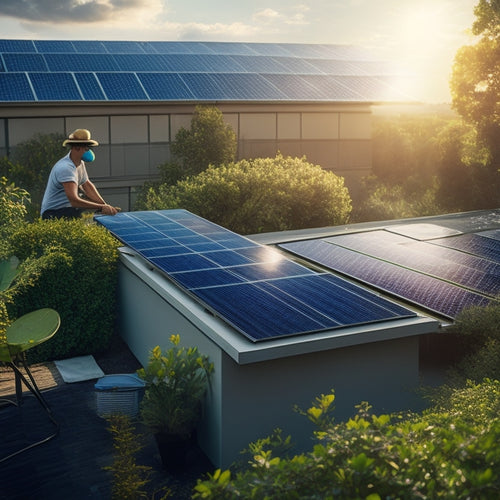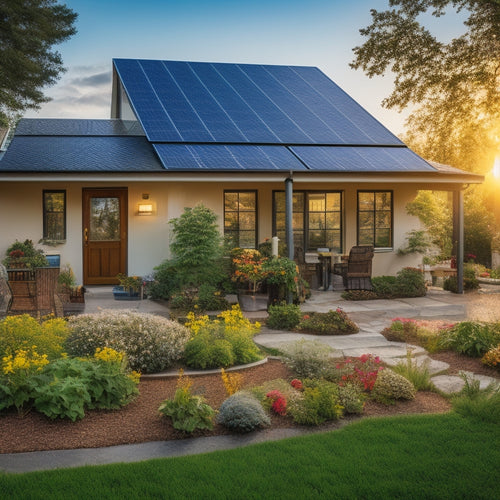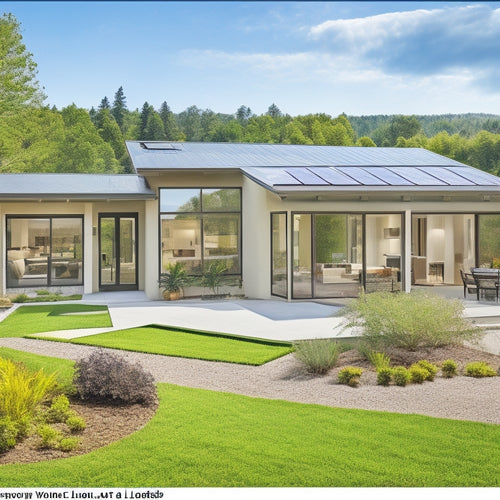
3 Ways to Cut Energy Costs With Renewable Energy
Share
You can greatly reduce your energy bills by shifting to renewable energy sources, which not only cut your energy costs but also minimize your carbon footprint. One way is by harnessing solar energy through installing solar panels and pairing them with energy storage systems. Another option is reducing energy consumption with wind turbines, choosing the right turbine size and placement, and incorporating energy storage solutions. Additionally, you can lower your bills with geothermal options, such as installing a geothermal heat pump, utilizing the Earth's constant temperature, and saving up to 70% on energy bills. There's more to explore in your journey to cutting energy costs with renewable energy.
Key Takeaways
• Shift to renewable energy sources like solar, wind, and geothermal to reduce reliance on traditional energy sources and cut energy costs.
• Install solar panels or wind turbines to generate electricity and pair them with energy storage systems for optimal benefits.
• Leverage geothermal options like heat pumps for efficient heating and cooling, saving up to 70% on energy bills.
• Optimize renewable energy systems with energy storage solutions to store excess energy for later use and reduce energy consumption.
• Explore various renewable energy solutions to find the best fit for your energy needs and maximize energy cost savings.
Harnessing the Power of Solar Energy
As you consider alternatives to traditional energy sources, you can tap into the abundant energy of the sun, which shines brightly on your roof, waiting to be harnessed.
By installing solar panels, you can generate electricity and reduce your reliance on the grid. These panels convert sunlight into electrical energy, which can power your home or business.
To maximize the benefits, consider pairing your solar panels with energy storage systems, such as batteries. This allows you to store excess energy generated during the day for use during the night or on cloudy days.
With solar panels and energy storage, you can take control of your energy costs and reduce your carbon footprint. By harnessing the power of the sun, you can enjoy clean, renewable energy and significant savings on your energy bills.
Reducing Energy Consumption With Wind
You can further reduce your reliance on traditional energy sources by harnessing the power of wind, which can be particularly effective in regions with strong and consistent breeze patterns. By installing wind turbines, you can generate electricity and reduce your energy consumption.
The key to maximizing wind power is to choose the right turbine size and placement, taking into account wind speed and direction. Additionally, incorporating energy storage solutions, such as batteries, enables you to store excess energy generated during peak wind periods for later use.
This hybrid approach guarantees a stable and reliable energy supply, reducing your reliance on the grid and lowering your energy costs. By combining wind power with energy storage, you can take control of your energy consumption and enjoy significant cost savings.
Lowering Bills With Geothermal Options
Geothermal energy, which leverages the Earth's natural heat to provide warmth and cooling, can greatly reduce your energy bills by minimizing your reliance on traditional HVAC systems.
By installing a geothermal heat pump, you can tap into the Earth's constant temperature to heat and cool your home. This system consists of an indoor unit connected to an underground Earth Loop, which circulates fluid to absorb or release heat.
With a geothermal system, you can save up to 70% on your energy bills. Plus, it's a clean and reliable source of energy.
Frequently Asked Questions
Can I Install Renewable Energy Systems Myself?
'Exploring the unfamiliar, you're enthusiastic to take on the DIY challenge of installing renewable energy systems yourself. However, without electrical expertise, you may be treading carefully; it's essential to weigh the risks and consider seeking professional guidance.'
How Long Does It Take to See a Return on Investment?
You'll typically see a return on investment within 5-10 years, depending on your system's cost and energy savings. Calculate your payback period by analyzing the financial breakdown of your renewable energy system's costs and benefits.
Are Renewable Energy Systems Durable and Long-Lasting?
You'll find that renewable energy systems are built to last, with high-quality materials ensuring durability; by following recommended maintenance schedules, you can maximize their lifespan and optimize performance over time.
Can I Use Renewable Energy Systems in Rural Areas?
You can effectively deploy renewable energy systems in rural areas, leveraging rural infrastructure to enable off-grid living, where remote accessibility isn't a limitation, and contributing to rural development through sustainable energy solutions.
Are There Government Incentives for Renewable Energy Adoption?
You can leverage government incentives for renewable energy adoption, such as Tax Credits and Policy Updates, to reduce costs and increase ROI; these incentives vary by state and country, so research what's available to you.
Related Posts
-

Green Ways to Maintain Solar Panels
To maintain your solar panels sustainably, start with regular inspections to catch potential issues early, enhancing ...
-

How to Achieve Energy Independence at Home
To achieve energy independence at home, start by investing in renewable energy sources like solar panels, wind turbin...
-

Passive Solar Design Strategies for Homes
To effectively implement passive solar design strategies in your home, focus on ideal building orientation and strate...


